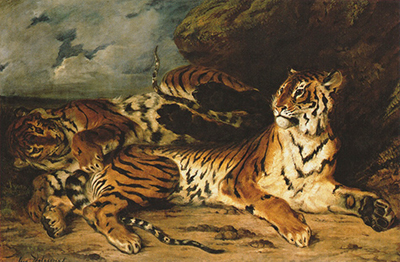One of the common sights found within the Romanticist movement were depictions of animals. Delacroix himself captures lions and tigers many times, including with this painting from 1830–31.
The composition in front of us features two tigers, as mentioned in the title. They lay in front of a rocky landscape a top a sandy, bare ground. In the background is a blue sky with some elements of white cloud. Much of the scene is darkened by shadows added from the rocks, but care is given to adding light to the nearest tiger so that the artist can display his skills in capturing exotic creatures. He would have to have practiced and studied these creatures for many years in order to truly understand their makeup, and each animal has its own unique aspects which need to be understood individually. There are countless examples of animal paintings from other artists which look like humans or a different species entirely. During the 19th century it would have been harder to see creatures such as this close up, and so odd interpretations were fairly common.
Thankfully, Delacroix was an artist who ensured a high level of quality within all of the different genres in which he worked. Every element is faithfully produced, down to the paw which is opened to the viewer in this piece. The background elements in this painting are similar to those found in many other Delacroix paintings and so could have been produced without an awful lot of thought or planning. He most likely would have put those in first, around a loose outline for the tigers. They would then be added afterwards, with them being the key element of the scene and also the item which would have challenged him the most. The colours, facial features, the prints across the fur and also the individual limbs of these animals all seem accurate and entirely believable.
This memorable piece can be found in the collection of the The Metropolitan Museum of Art, New York. It celebrates the delight in wildness that Romanticists made us of many times. The artist also used animals as a way of displaying human behaviour in a form of symbolism. Some have argued that the tigers in this painting are an extension of how he sees himself, and their behaviour is directly his own. He would also give us other related artworks such as Tiger, Tiger and Snake and Lion Hunt which provided alternative arrangements of these beautiful and powerful creatures. Those interested in the history of animal painting should also check out the paintings of Albrecht Durer which included a number of charming watercolours of all manner of different animals many centuries ago.




